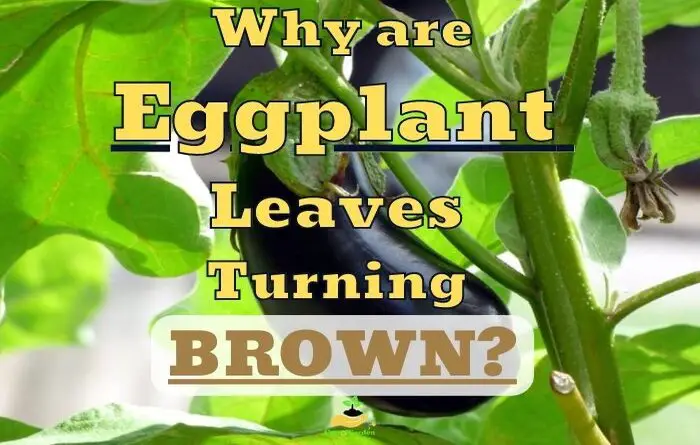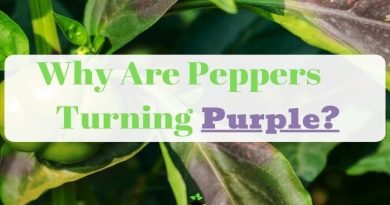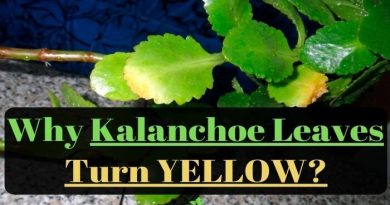Why are Eggplant Leaves Turning Brown? [5 Surprising Reasons]
Eggplant, also known as aubergine, is a popular vegetable widely grown for its delicious and versatile fruit. However, sometimes the leaves of the eggplant plant start turning brown, which can be concerning for gardeners and farmers alike.
This phenomenon can happen due to various reasons, such as pest infestations, environmental stress, or disease. In this article, we will explore the main causes of eggplant leaves turning brown and discuss possible solutions to keep your eggplant plants healthy and thriving.
| Why are Eggplant Leaves Turning Brown |
|---|
| 1. Lack of water |
| 2. Insect and pest invasions |
| 3. Exposure to harsh temperatures |
| 4.Poor Soil Drainage |
| 5. Overcrowding. |
| 6. Soil that is deficient in nutrients and minerals |
| 7. Excessive use of Fertilizers |
| 8. Diseases |
1. Lack Of Water
Eggplants require a lot of water to grow properly, so keeping them adequately watered throughout the season is essential. Lack of enough moisture in the soil will affect your eggplant production and in some cases can cause the leaves to turn brown and become soft.
The best way to tell if there is enough moisture content in the soil is by looking at the bottom of the eggplant leaves. If the leaves are turning brown, there is a lack of enough moisture in the soil, and you need to water them.
Another way to know whether your eggplants are getting enough water is by looking at the skin. If the skin is turning brown, looks wrinkled and dry, and feels like plastic, this is a sign of insufficient moisture.
Treatment
To fix this issue, try adding more water to your potting soil and giving the eggplant a good soak now and then.
In normal conditions, eggplants must receive at least one inch of water per week and two inches per week in hot, dry weather. It is recommended to supply most of this water in a single session at an average temperature and twice a week in extreme heat.
2. Insect And Pest Invasions
Check your eggplants for signs of illness or pests if their leaves are turning brown or not producing healthy fruits. Insects lurk beneath the leaves, making them difficult to detect, and they can significantly impact your plant’s growth.
Prevention is essential, so monitor your plants weekly and don’t let the damage get out of hand. The following insects are the most dangerous to sensitive eggplants:
- Aphids cause the leaves to curl and hinder plant growth.
- Flea beetles typically attack seedlings and cause them to turn brown, but once the plants mature, they can defend themselves.
- Spider mites strike in hot weather, weaving a web across the leaf and sucking the sap from the plant, thus affecting the eggplant fruits.
- Colorado potato bugs and hornworms eat on leaves quickly and can damage entire crops.
Eggplant is prone to insect damage, especially in warm weather. Insects like aphids can cause the leaves to become spotted and discolored. It’s essential to watch for pests on your eggplants, especially when they start to produce flowers and fruit.
Treatment
Organic pest control approaches, particularly mechanical methods, can combat these pests. Water can repel aphids, and more giant insects can be picked manually.
When the seedlings are young, cover them with netting or horticultural fleece. When everything else fails, use insecticidal soap, neem oil, or one of the many other available choices.
3. Exposure To Harsh Temperatures
Eggplants aren’t designed to thrive in temperate climates, so it’s no wonder they despise weather that isn’t in their comfort zone. When the weather isn’t suitable, the eggplants sometimes end up turning brown or dying.
If the temperature falls below 60°F (16°C), the eggplants may shed their blossoms and fail to produce healthy fruit. Lower temperatures limit numerous essential processes, and the plant enters survival mode, discarding its fruits.
There isn’t much you can do about it except grow your sensitive plants undercover if your environment is hostile.
When the weather grows scorching, above 90°F (32°C), the eggplant’s pollen may become dormant or the health of the eggplant may be affected. Temperature swings also strain the plant’s overall system, causing it to stop thriving until the weather improves.
Treatment
Eggplants thrive in full sun. Therefore, putting them in the shade to avoid scorching heat is also not viable. The greatest thing you can do is shelter your plants with shade cloth during the hottest portion of summer, especially in the afternoon.
4. Poor Soil Drainage
Another reason why eggplant leaves are turning brown and losing their vivid hue, is if there is a problem with the soil drainage system.
The most straightforward approach to avoid or solve this problem is by making sure you’re watering your plants correctly; they should get enough water but not too much.
Poor drainage in the soil can occur when there is a lot of clay in the ground and not enough drainage, resulting in additional moisture buildup, rotting or plant infection. So, if you notice your eggplant going brown, try digging out some new dirt and avoid planting in areas with too much clay soil.
You can also keep this from happening by placing them on raised beds or containers with adequate drainage holes at the bottom. Ensure the soil around the plant’s base is moderately damp.
5. Overcrowding
Overcrowding occurs when too many plants are in a given area, causing them to compete for resources. Eggplants are particularly sensitive to crowding. Hence, if they are in a crowded environment, they will be prone to turn brown and get lesions.
The simplest way to avoid this problem is to give each plant its spot in the garden and ensure that no other plants are nearby. Additional lighting can be added if necessary.
6. Excessive use of Fertilizers
Eggplant leaves are susceptible to turning brow when the soil pH is too high. They need neutral or slightly acidic soil to grow properly, so if you’re using chemical fertilizers or your garden soil is over-fertilized, you may be causing your eggplants to turn brown.
When you apply too much fertilizer to your eggplant plants, they will drown in excess and turn brown. This is a common issue with many gardeners who use excessive chemical fertilizers or improper timing when they apply their fertilizer.
To prevent this from occurring, make sure you use the recommended fertilizer for your specific crop type. If you have any questions about whether to add additional nutrients to your soil or if you need to adjust your timing of applying it, consult with a professional before using more nutrients than necessary.
Another possible cause of browning on your eggplants is an excess amount of potassium in the soil. If this is the case, consider using a fertilizer with less potassium and more nitrogen than usual.
7. Soil That Is Deficient In Nutrients And Minerals
Deficient nutrients could also be the reason why your eggplants leaves are turning brown. During the bearing phase of the plant, eggplants prefer well-drained, sandy soil that’s also rich in minerals, specifically nitrogen and phosphorus.
These minerals enable tour eggplants to bear healthy fruits. Potassium, phosphorus, and magnesium are also significant elements. All these elements can be added to the soil by regularly applying organic fertilizers.
Treatment
Always use a balanced fertilizer (10-10-10), and only overfeed the eggplants – up to every four weeks. Organic alternatives include fish fertilizer, composted tea, bat guano, and seaweed.
Planting eggplant seedlings in swampy, moist soil might result in fungal disease and reduced growth. By adding organic matter to your soil, you can strengthen its structure.
Compost is consistently the answer to improved crops, and a covering of 4 to 6 inches of manure will do miracles for the design and nutrient levels of your soil.
8. Disease
Verticillium wilt of eggplant
Dry brown spots with a yellowish border are formed on the leaves, stem of the plant on the cut is black with brown vessels. Soon the leaves dry up completely.
Usually the disease develops in years when there are sharp alternations of frost and heat.
Verticillium wilt is caused by a fungus, Verticillium dahliae. This disease generally develops fairly quickly, in the spring when it is humid. Your eggplant leaves will soften before turning yellow, sometimes just on one side of the midrib.
They end up turning brown and becoming necrotic, without falling off. If you cut a stem with a pruner , you can see by looking at the cut that only the center is green. The fruits develop but remain very small.
Treatment
In prevention, use manure or a decoction of horsetail to spray on the eggplant plants at the beginning of their culture, several times. Be careful not to injure the stems of the eggplant, especially at the collar.
Plant your eggplants in well-drained soil. Watch out for excess nitrogen. When the disease has set in, there is nothing to do, the diseased foot should be pulled out and burned as soon as possible. Avoid growing eggplants and other vegetables of the same family (tomatoes and potatoes) in the same place for 3 years.
Phytophthora blight
The appearance of dark brown spots on eggplant seedlings is one of the most alarming symptoms, indicating the attack of plants by black bacterial spot. It can develop at any stage of growth. The affected areas are dark in color with a yellow border.
Unfortunately, the plant cannot be cured – it remains only to destroy all the affected specimens. The soil in the common container must be changed, it is recommended to ignite the new earth in the oven, and treat the containers with boiling water.
Prevention measures include the use of proven planting material and pre-treatment of seeds before sowing.
Early Blight
When the eggplant begins to suffer the effects of Alternaria solani, dark brown spots are observed on the leaves. As these lesions grow, they will develop concentric patterns and a yellow halo around them and spread throughout the crop.
In addition, the same fruit may develop dark spots caused by this unpleasant fungus, which will cause it to fall prematurely.
The disease begins in eggplant with the appearance of brown spots and a marked yellowish border. It presents a rounded and concentric shape in these spots. It is known as black mold and is typical of areas of high humidity and temperature.
This disease begins by attacking the lower areas of the crop and then progresses to the upper leaves.
Active substances accepted against alternaria in the cultivation of eggplant.
Downy mildew
Eggplant downy mildew is caused by Phytophthora infestans . Symptoms are visible on stems as oily-looking gray-brown spots, on leaves as brown spots and a white down on the underside.
Fruits are mottled brown, bumpy and hard. This disease develops during wet days from May to September. It is accentuated by poor ventilation (leaves, distance between plants).
Treatment
The fungus that causes this disease likes humid atmospheres, so be sure to plant eggplants so that air circulates well between them. Spray manure or horsetail decoction, alternate with Bordeaux mixture.
Remove affected leaves as soon as the first symptoms appear. Always water at the foot. Crop rotation is always a good way to control disease.
Conclusion
In conclusion, browning of eggplant leaves can be caused by a variety of factors, including pest infestations, environmental stress, and disease. It is important to diagnose the root cause of the problem in order to find the appropriate solution.
Whether it’s providing adequate water, adjusting light and temperature conditions, or treating pests and diseases, taking the necessary steps to prevent and fix eggplant leaves from turning brown can ensure a healthy and bountiful eggplant crop.




